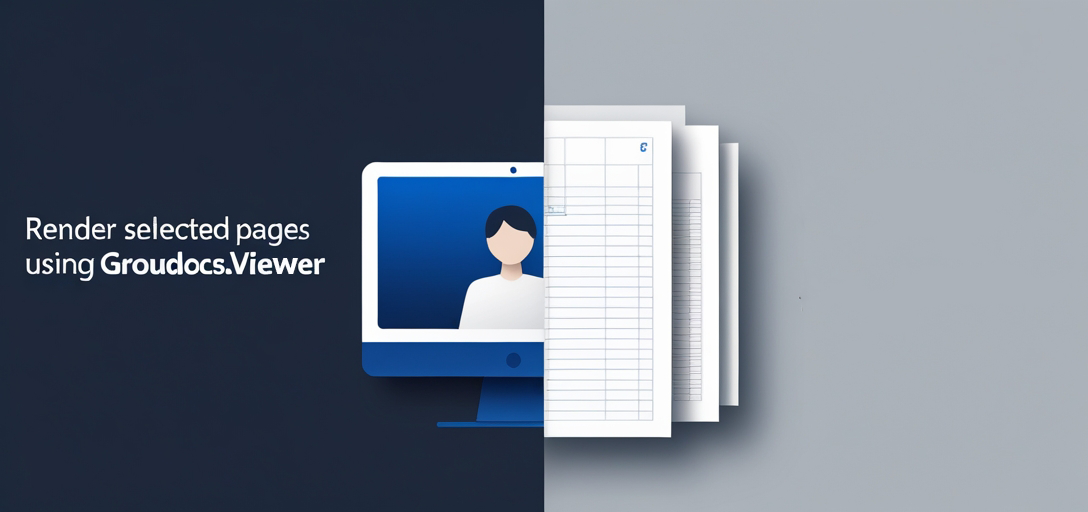How to Render Specific Pages Using GroupDocs.Viewer .NET
Introduction
Need to display only certain pages from a large document without overwhelming your application or users? The GroupDocs.Viewer .NET library lets you seamlessly render specific pages from any supported document type, ideal for handling extensive reports or contracts. This tutorial will guide you through using the GroupDocs.Viewer library for rendering selected pages of a document.

By the end, you’ll know how to set up and customize your application for efficient page rendering:
- Installing GroupDocs.Viewer .NET
- Setting up your environment for document rendering
- Rendering specific pages from any supported format
- Optimizing performance and resource management
Prerequisites
To follow this tutorial, ensure you have the following in place:
Required Libraries, Versions, and Dependencies
Install GroupDocs.Viewer for .NET to render various document formats into HTML, images, or PDFs with ease.
Environment Setup Requirements
- Visual Studio (2017 or later)
- .NET Framework 4.6.1 or higher, or .NET Core
- Basic understanding of C# and .NET application development
Knowledge Prerequisites
Familiarity with file operations in .NET and experience using the NuGet package manager is beneficial.
Setting Up GroupDocs.Viewer for .NET
To get started with GroupDocs.Viewer, install the library in your project via the NuGet Package Manager Console or the .NET CLI:
NuGet Package Manager Console
Install-Package GroupDocs.Viewer -Version 25.3.0
.NET CLI
dotnet add package GroupDocs.Viewer --version 25.3.0
License Acquisition Steps
Before diving into implementation, consider obtaining a license for full access to the library’s features:
- Free Trial: Start with a free trial to test the capabilities.
- Temporary License: Request a temporary license if you need more time.
- Purchase: For long-term use, purchasing a license is recommended.
Here’s how you can initialize GroupDocs.Viewer in your C# application:
using System;
using GroupDocs.Viewer;
// Initialize Viewer with input document
class DocumentViewer
{
public void RenderDocument(string filePath)
{
using (Viewer viewer = new Viewer(filePath))
{
// Configuration or operation code here
}
}
}
Implementation Guide
Feature: Render Selected Pages
This feature allows rendering specific pages from a document, focusing on relevant content without loading the entire file.
Step 1: Define Paths and Ensure Output Directory Exists
Specify paths for your input document and output directory. If the output directory doesn’t exist, create it:
string inputFilePath = Path.Combine("YOUR_DOCUMENT_DIRECTORY", "TestFiles.SAMPLE_DOCX");
string outputDirectory = "YOUR_OUTPUT_DIRECTORY";
if (!Directory.Exists(outputDirectory))
{
Directory.CreateDirectory(outputDirectory);
}
This setup ensures your application has a designated place to save rendered HTML files.
Step 2: Set Up View Options
Configure the HtmlViewOptions to specify how and where pages should be saved. Here, we’re saving them as embedded resources:
string pageFilePathFormat = Path.Combine(outputDirectory, "page_{0}.html");
HtmlViewOptions options = HtmlViewOptions.ForEmbeddedResources(pageFilePathFormat);
Step 3: Render Specific Pages
Use the Viewer object to render only the pages you need. In this example, we render the first and third pages:
using (Viewer viewer = new Viewer(inputFilePath))
{
// Render the first and third pages of the document
viewer.View(options, 1, 3); // Pages are indexed starting from 1
}
Troubleshooting Tips
- Ensure file paths are correct to prevent
FileNotFoundException. - Check for permissions on directories where files are read or written.
- If encountering performance issues, consider optimizing page rendering settings.
Practical Applications
GroupDocs.Viewer .NET can be integrated into various scenarios:
- Legal and Financial Industries: Render specific contract sections in client-facing applications.
- Educational Platforms: Display selected pages of textbooks or reference materials.
- Internal Document Management Systems: Allow employees to view only relevant document portions.
Performance Considerations
To ensure optimal performance while using GroupDocs.Viewer:
- Limit the number of pages rendered at a time to conserve memory.
- Use embedded resources for faster load times in web applications.
- Manage resource cleanup by disposing of
Viewerobjects after use.
These practices help maintain smooth application performance and efficient memory usage.
Conclusion
We’ve walked through setting up GroupDocs.Viewer .NET to render specific pages from documents. This functionality is invaluable when dealing with large files, enabling you to focus on relevant content efficiently. Implement this solution in your project and enhance user experience by rendering only what’s necessary!
FAQ Section
Q1: What file types can GroupDocs.Viewer .NET handle for page rendering? A: It supports a wide range of formats including DOCX, PDF, XLSX, PPTX, and more.
Q2: How does rendering specific pages improve application performance? A: By loading only necessary content, you reduce memory usage and processing time.
Q3: Can I customize the output format when rendering pages? A: Yes, GroupDocs.Viewer allows rendering into HTML, images, or PDFs with customizable options.
Q4: What should I do if a document can’t be rendered due to permission issues? A: Ensure your application has read access to the document and write permissions for the output directory.
Q5: Are there any limitations on the number of pages I can render at once? A: While technically possible, rendering large numbers of pages simultaneously may impact performance. It’s best to limit this according to your system’s capabilities.
Resources
- Documentation: GroupDocs.Viewer .NET Documentation
- API Reference: API Reference Guide
- Download: Get the Latest Version
- Purchase & Licensing: Buy GroupDocs.Viewer .NET
- Free Trial: Try for Free
- Temporary License: Request a Temporary License
- Support Forum: Community Support